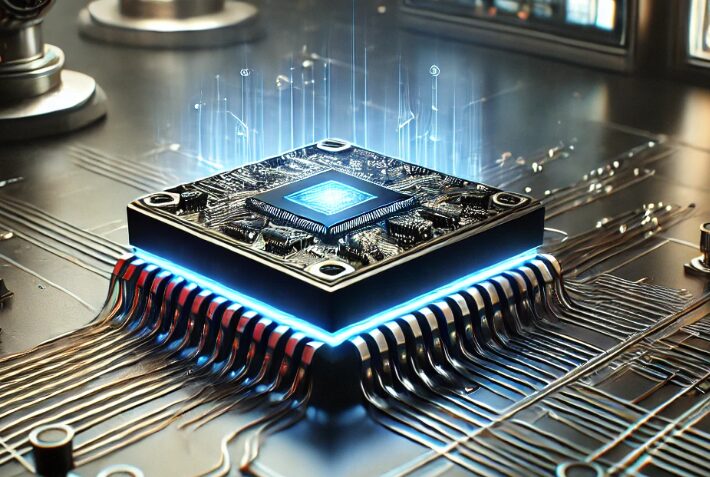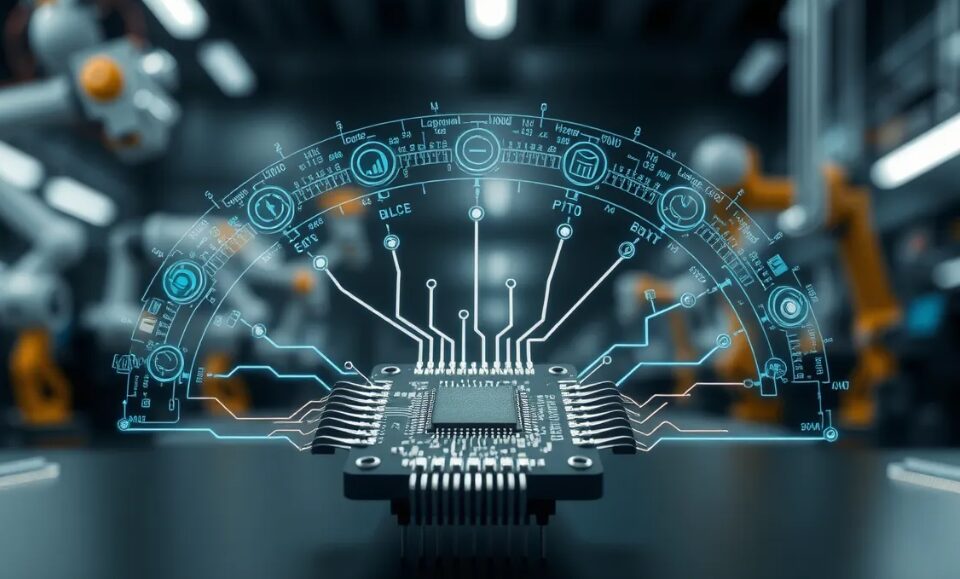
Unlike traditional AI, which processes data in centralized cloud servers, edge AI shifts that intelligence directly to devices themselves. No middleman. This shift is crucial because it brings faster responses, greater security, and enhanced privacy.
In industries like healthcare, automotive, and even home automation, AI on the edge is poised to make systems smarter and more responsive.
Embedded systems and AI: A powerful combination
Embedded systems are the backbone of this revolution. These systems are tiny, specialized computers integrated into devices, from smart thermostats to industrial robots. When you pair these with artificial intelligence, you’re looking at a new level of innovation. By embedding AI into these systems, devices can not only follow pre-programmed instructions but also adapt, learn, and optimize their performance on the go.
Now, this sounds amazing, but there’s one more key factor in this equation that makes everything possible: the programming language. And for embedded AI, there’s one clear winner—C.
Why C is the language of choice for embedded AI
You might be wondering: Why not Python, which everyone loves for AI? Well, in the world of embedded systems, performance and resource management are king. And that’s where C shines. C allows developers to write code that is close to the hardware, giving them control over memory usage and processing power. This kind of control is essential in devices that don’t have the luxury of endless computational power, like a cloud server might.
C’s lightweight, efficient nature makes it perfect for real-time applications where AI must act swiftly and with minimal delays.
Maximizing efficiency with C in edge AI
In edge AI, efficiency is everything. Devices running AI algorithms in real-time often have to balance performance with limited battery life and memory. C enables developers to fine-tune applications down to the last byte, ensuring that AI can perform optimally even on minimal hardware.
For example, imagine an AI-enabled camera on a drone. It needs to recognize objects, avoid obstacles, and track moving targets—all in real-time. C allows the software controlling the camera to run lean and fast, ensuring it doesn’t overtax the system’s resources, keeping both performance and power consumption in check.
Real-world examples of AI-driven embedded systems

Now, let’s step into the real world to see how embedded AI systems powered by C are making waves. Take self-driving cars as an example. These vehicles rely heavily on AI running on embedded systems to make split-second decisions. Everything from identifying pedestrians to merging lanes is handled by AI algorithms coded in C to ensure they run efficiently on the car’s hardware.
Another great example? Wearable health monitors. Devices like smartwatches now offer real-time heart monitoring, detecting irregularities instantly. This is only possible through the tight integration of C-based embedded systems and AI models. They allow these compact devices to deliver results quickly and accurately without needing a constant internet connection.
Overcoming challenges: Limited resources in embedded AI
With embedded AI systems, one of the toughest hurdles is working with limited resources. Edge devices don’t have the luxury of vast memory, storage, or processing power like cloud-based systems. These constraints mean that developers have to get creative. The beauty of C is that it thrives in environments with tight resource limitations. It provides the tools necessary to write highly optimized code that maximizes every bit of RAM and processing capability.
Yet, balancing performance and resource use is no easy feat. AI algorithms, particularly machine learning models, can be quite demanding in terms of memory and compute power. The challenge lies in shrinking these models to fit within the narrow confines of embedded systems, and that’s where model compression techniques come into play, enabling developers to keep functionality high while reducing footprint.
The role of machine learning in edge AI
When you think of AI at the edge, machine learning (ML) is often at the heart of it. ML allows systems to make predictions, recognize patterns, and even learn from past interactions. But here’s the twist—most machine learning models are originally designed for powerful hardware. Running them on embedded systems requires a whole new set of tricks.
This is where tinyML comes into the picture. It’s a subset of machine learning focused on creating lightweight models capable of running on devices with limited resources. With C, developers can tailor these algorithms to ensure they run smoothly and efficiently on the edge, transforming even small, everyday devices into intelligent systems.
Optimizing hardware for embedded AI systems
Software is just half the battle—hardware optimization is key to making edge AI a reality. Embedded systems running AI are designed to squeeze maximum performance out of minimal hardware. That’s why choosing the right microcontrollers or system-on-chips (SoCs) is critical.
Pairing optimized hardware with the lightweight code written in C can make all the difference. For example, using digital signal processors (DSPs) or graphics processing units (GPUs) for parallel processing can significantly boost AI performance. Developers who are savvy with C can design systems that offload intensive tasks to specialized hardware, leaving the main processor free to handle other duties. It’s a delicate dance of balancing power consumption, processing speed, and real-time responsiveness.
Security concerns in edge AI and embedded systems

As AI systems move closer to the user, security becomes a major concern. With edge devices making decisions locally, the data they process is more vulnerable to attacks. Imagine a self-driving car being hacked or a health monitor being tampered with—these are the kinds of risks developers have to address.
Security measures like encryption, authentication, and secure coding practices are crucial. Luckily, C’s close-to-the-metal approach allows for better control over how data is handled, ensuring tighter security protocols can be implemented directly into the code. This is especially important in fields like healthcare and finance, where data privacy is non-negotiable.
How C ensures real-time performance in AI tasks
One of the biggest advantages of C in the world of embedded AI is its ability to guarantee real-time performance. Real-time applications can’t afford delays. For example, a robot in a factory making millisecond-level decisions about moving parts must rely on immediate and accurate responses from its AI system.
C excels at managing low-level hardware interactions and interrupt handling, allowing developers to design AI systems that react instantly. The language’s efficiency ensures there’s minimal lag between input and response, making it perfect for time-sensitive applications like robotics, industrial automation, or autonomous vehicles.
The importance of low latency in edge AI
Closely tied to real-time performance is latency. In edge AI, low latency is essential. Whether it’s a security camera identifying an intruder or a smart traffic light adjusting to traffic flow, the system’s ability to react in milliseconds is crucial. C allows developers to minimize latency by writing optimized, hardware-specific code that cuts down on processing time.
In a cloud-based system, latency is often affected by data traveling back and forth between the device and the cloud server. Edge AI eliminates this problem by keeping computations local, and when coded in C, these systems can offer lightning-fast responses. This can be the difference between a system that works in theory and one that works in the real world, especially in safety-critical applications like medical devices or autonomous drones.
Future trends: AI and embedded systems
The future of AI in embedded systems is incredibly exciting. We’re already seeing the integration of AI in everyday gadgets, but it’s only the beginning. As 5G networks become more widespread, they’ll enable faster data transfer and real-time processing, even on edge devices. This means we’ll see even more sophisticated AI applications, like advanced augmented reality (AR) experiences, ultra-responsive smart cities, and next-level autonomous vehicles.
Another trend is the increasing adoption of neuromorphic computing, which mimics the human brain’s neural structure. These chips, optimized for running AI algorithms, are energy-efficient and designed for real-time learning. Combined with C programming, they offer a perfect blend of performance and adaptability for embedded systems. With this technology, the potential for AI at the edge will expand exponentially, enabling devices to not only perform tasks but to learn and improve over time.
Using C to power AI algorithms at the edge
When it comes to powering AI algorithms at the edge, C’s role is pivotal. Most AI algorithms, especially in deep learning and machine learning, require intensive computational resources. Running these algorithms in their full form on edge devices is often impractical. But here’s where C makes a difference. By enabling the creation of optimized code, C helps convert complex algorithms into efficient, lightweight versions that can run on microcontrollers and other embedded hardware.
For instance, imagine deploying a convolutional neural network (CNN) for image recognition on a tiny drone. By using C, developers can strip down the algorithm to its most essential components, ensuring it runs effectively on the drone’s limited hardware, without compromising on accuracy or speed. This fine-tuning capability is what makes C the unsung hero in embedded AI development.
Tools and frameworks for C-based embedded AI
You might wonder, “How do developers actually build these AI systems using C?” Thankfully, there’s a suite of tools and frameworks available to make the process smoother. TensorFlow Lite for Microcontrollers is one such framework, allowing developers to deploy machine learning models on microcontroller units (MCUs). It’s tailored for low-power, resource-constrained environments, making it ideal for embedded AI.
Another essential tool is Edge Impulse, which simplifies the process of building and deploying AI models on edge devices. It offers a streamlined pipeline that converts models into C code, ensuring they can run efficiently on embedded systems. Then there’s CMSIS-NN, a library optimized for running neural networks on ARM Cortex-M processors, offering developers pre-optimized C code to implement AI algorithms in real-time.
The impact of 5G on edge AI applications
The introduction of 5G technology is set to be a game-changer for edge AI. With its incredibly fast data transfer speeds and ultra-low latency, 5G networks enable edge devices to communicate and process data more effectively. This means more complex AI models can be deployed on embedded systems, as they can now rely on real-time data and cloud resources when necessary, without experiencing delays.
Imagine a smart factory where machines communicate with each other, processing AI-driven decisions in milliseconds. Or think about smart traffic management systems that adapt to real-time traffic patterns, ensuring smooth traffic flow and reducing congestion. These applications will become more efficient and widespread as 5G networks expand, making edge AI even more powerful.
Key takeaways for developing embedded AI solutions
Developing embedded AI solutions isn’t just about choosing the right programming language—though, as we’ve seen, C is a solid choice. It’s about understanding the unique constraints and opportunities of edge devices. Resource management, efficiency, and security are paramount, and this means thinking differently than you would when building traditional, cloud-based AI systems.
Here are a few key takeaways:
- Optimize early and often: Start with efficient code from day one. The more you can optimize your AI algorithms, the better they’ll perform on limited hardware.
- Leverage available tools: Take advantage of frameworks like TensorFlow Lite for Microcontrollers and Edge Impulse. These tools streamline development and make it easier to deploy AI models on embedded systems.
- Prioritize security: Edge devices are often less protected than cloud systems. Implement encryption and authentication measures directly within your C code to safeguard data and functionality.
Moving forward: The potential of AI in edge devices
AI on the edge is a thrilling frontier that’s only just beginning to reveal its full potential. By leveraging the power of C, developers can build intelligent systems that operate efficiently even with limited resources. These systems can run faster, adapt more quickly, and process data locally, ensuring real-time responses in critical applications.
As we continue to integrate AI into more aspects of daily life—smart cities, healthcare, transportation—the combination of embedded systems and AI will become indispensable. And with C as a reliable and efficient language at the helm, the future of edge AI looks incredibly bright. We’re heading towards a world where devices don’t just respond—they anticipate, adapt, and learn, all thanks to the power of AI on the edge.
FAQs
What is edge AI, and how does it differ from traditional AI?
Edge AI refers to artificial intelligence that processes data locally on devices, rather than relying on a cloud server for data processing. This reduces latency, improves privacy, and allows real-time decision-making. Traditional AI, on the other hand, often processes data remotely on powerful cloud servers, requiring data to be sent back and forth, which can cause delays.
Why is C the preferred language for embedded AI systems?
C is widely used in embedded AI systems because of its efficiency and control over low-level hardware operations. It allows developers to optimize code for real-time performance, minimal memory usage, and low power consumption, which is crucial for devices with limited resources, such as microcontrollers and IoT devices.
What are the benefits of using AI at the edge?
- Reduced Latency: Local processing enables faster response times.
- Improved Security: Sensitive data stays on the device, reducing the risk of breaches.
- Lower Bandwidth Usage: Since data doesn’t need to be sent to the cloud, bandwidth demands decrease.
- Increased Reliability: Devices continue to function even without internet access.
Can machine learning models be run on embedded systems?
Yes! Though traditional machine learning models can be resource-intensive, new methods like TinyML and model compression techniques make it possible to run smaller, more efficient models on embedded systems. Using C, these models can be optimized for low-power devices while maintaining accuracy.
What is TinyML, and how does it relate to edge AI?
TinyML is a branch of machine learning that focuses on running machine learning models on resource-constrained devices, like sensors and microcontrollers. It allows AI to be deployed on edge devices, enabling intelligent decision-making without the need for powerful hardware.
How does 5G impact edge AI?
5G‘s high speed and low latency make it ideal for edge AI applications. It enables faster data transfer between devices and real-time cloud communication when necessary, improving the performance of smart cities, autonomous vehicles, and IoT applications by allowing more complex AI algorithms to run effectively on edge devices.
What are the biggest challenges in developing AI for embedded systems?
The main challenges include:
- Limited Resources: Edge devices often have minimal memory, processing power, and energy.
- Optimization: AI algorithms need to be compressed and optimized to run on small hardware.
- Security: Local processing can increase the risk of data breaches, requiring extra security measures.
What tools are available for C-based AI development on embedded systems?
Some popular tools and frameworks include:
- TensorFlow Lite for Microcontrollers: Allows developers to run lightweight ML models on resource-constrained devices.
- Edge Impulse: Helps build and deploy machine learning models optimized for edge devices.
- CMSIS-NN: A library for running neural networks on ARM Cortex-M processors, offering pre-optimized C code.
How does C help ensure real-time performance in AI tasks?
C allows developers to interact directly with hardware, manage memory efficiently, and handle interrupts precisely, ensuring that AI algorithms can run with minimal delay. This is critical for real-time applications like robotics, automotive AI, and industrial automation, where milliseconds can make a big difference.
What are the security concerns with AI on edge devices?
Edge devices can be vulnerable to cyber-attacks because they process data locally. To mitigate this, developers need to implement robust encryption, authentication, and secure coding practices, ensuring that sensitive data is protected, even on small, resource-constrained devices.
What are some real-world examples of AI in embedded systems?
- Self-driving cars: Using AI to make real-time decisions based on sensor data.
- Wearable health monitors: Providing real-time heart rate and health analysis.
- Smart home devices: Adapting to user preferences and predicting needs.
- Industrial robots: Making millisecond-level decisions to optimize assembly processes.
What role does hardware play in embedded AI systems?
Optimized hardware is crucial for running AI on edge devices. Developers use microcontrollers, SoCs, and specialized processors like DSPs or GPUs to boost performance while minimizing power consumption. C allows for tight integration between software and hardware, ensuring that AI algorithms can take full advantage of the available resources.
How does C help reduce latency in edge AI applications?
By writing efficient, hardware-specific code, developers using C can significantly reduce processing time, ensuring that edge AI systems can react quickly. This is especially important in time-sensitive applications like smart security cameras, autonomous drones, or real-time analytics in healthcare.
What are the key factors to consider when developing embedded AI solutions?
Key considerations include:
- Efficiency: Code must be optimized for low power consumption and minimal memory usage.
- Real-time performance: AI must react instantly to inputs.
- Security: Protecting data processed locally on devices.
- Hardware compatibility: Ensuring the software is tailored to work with the device’s specific hardware.
Resources for AI on the Edge and Embedded AI Systems
1. Books:
- “Embedded Systems: Introduction to ARM Cortex-M Microcontrollers” by Jonathan W. Valvano
- A great resource for learning about embedded systems architecture and programming, focusing on microcontroller development.
- “Programming Embedded Systems in C and C++” by Michael Barr
- This book covers C and C++ programming for embedded systems, helping you grasp the essentials of writing efficient code for hardware-constrained environments.
- “Deep Learning for Embedded Systems” by Mohamed Abdellatif, Kassem Kallas
- A focused dive into how deep learning is adapted for embedded hardware, featuring real-world examples.
2. Online Courses:
- Coursera: “Embedded Systems Essentials with ARM”
- This course covers the basics of embedded systems programming with ARM-based processors, essential for running AI on edge devices. It includes C programming and real-time systems integration.
- Udemy: “Embedded Systems Programming on ARM Cortex-M3/M4”
- A beginner-friendly introduction to embedded systems with hands-on coding projects, ideal for understanding how C powers embedded systems.
- Edge Impulse Learning Hub
- Offers free tutorials and documentation for creating edge AI models and deploying them on embedded devices.
3. Developer Tools & Frameworks:
- TensorFlow Lite for Microcontrollers
- A lightweight machine learning framework designed to run on resource-constrained devices, with support for C-based deployment on microcontrollers.
- CMSIS-NN (ARM)
- Optimized libraries for running neural networks on ARM Cortex-M processors, helping developers use pre-optimized C code for edge AI.
- Edge Impulse
- Website
- A platform to build machine learning models for edge devices, offering tools to convert models into C code and deploy them on microcontrollers.
- Arduino AI Framework
- Website
- Supports edge AI development for various Arduino hardware, enabling C-based programming with libraries for neural networks and machine learning.
4. Communities & Forums:
- Stack Overflow: Embedded Systems and AI
- Website
- A valuable forum for troubleshooting and learning about C programming for embedded systems, as well as integrating AI into edge devices.
- ARM Developer Community
- A hub for resources and discussions on ARM architecture, with a focus on optimizing performance in embedded AI.
- EmbeddedRelated
- Website
- A community offering articles, tutorials, and discussions on embedded systems development, focusing on C and real-time applications.
5. Industry White Papers & Research Papers:
- “AI on the Edge: A Review of Embedded AI”
- A detailed paper covering trends and challenges in AI development on edge devices, with insights into the role of C programming for optimization.
- “TinyML: Machine Learning at the Edge”
- This whitepaper explores the TinyML movement and how developers are creating machine learning models for ultra-low-power devices, with a focus on practical applications in C.
- “Neural Network Inference on ARM Cortex-M”
- A technical paper discussing how to implement efficient neural network inference on ARM Cortex-M processors using CMSIS-NN.
6. YouTube Channels:
- Arm Software
- Offers tutorials and webinars on using C programming for embedded AI development and ARM-based systems.
- Edge Impulse YouTube Channel
- Provides hands-on tutorials for building and deploying edge AI models using C and other embedded development tools.
- The Embedded Systems Channel
- Focuses on C programming, real-time systems, and embedded development for edge devices, covering various hardware platforms.
7. Research & Innovation Blogs:
- NXP Semiconductors Blog
- A blog offering updates on advancements in embedded systems, edge AI applications, and efficient C programming for microcontrollers.
- NVIDIA Embedded AI Blog
- Website
- Focuses on edge computing and AI development, particularly for high-performance AI applications on edge devices.
- Adafruit Learning Blog
- Features tutorials and projects on building AI-powered devices with embedded systems and C, ideal for hobbyists and professionals alike.





